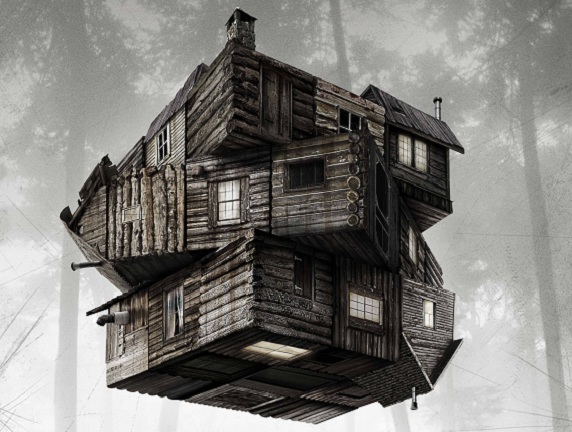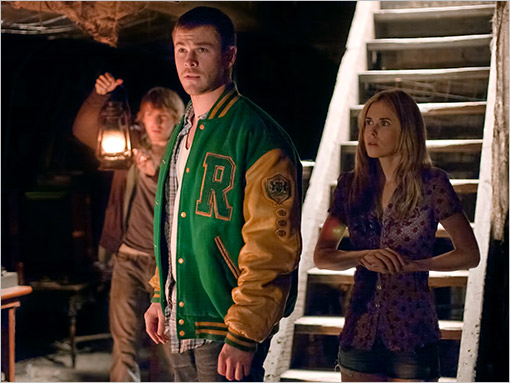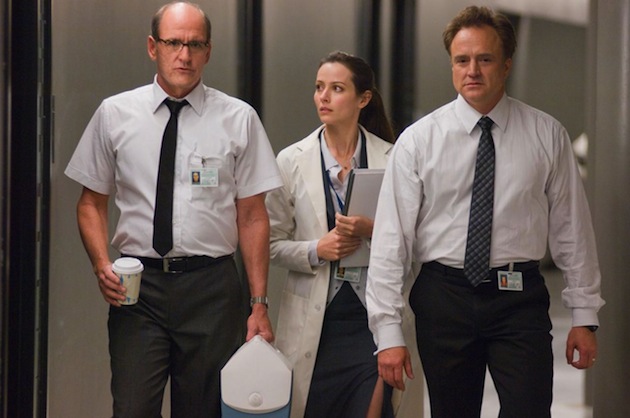
Courtesy of Lionsgate
Cabin In The Woods is the new horror film from Buffy, The Vampire Slayer collaborators Joss Whedon and Drew Godard. Expectations (and hype) are high after well-received festival screenings and the pedigree of the behind the scenes talent (which includes A Nightmare On Elm Street‘s Heather Langenkamp?!).
In the interest of those people who have seen the film and those who haven’t, I’m going to do an unconventional thing: I’ve written two reviews. The first half of the following piece is for people who want a quick review to decide whether or not to see the film. The second half is for people who have seen the finished product.
Let’s bitch it out…NEWBIES
If there’s one thing I could most strongly recommend for people considering seeing the film, it is this: know as little about the film as possible going in. This actually includes the trailer, which at first glance seems like a hodge podge of ill-fitting images, but in retrospect it’s a bit spoilery. Now if this isn’t an option, I will concede that even if you do know what the film is about or have an inkling of what you’re in store for, your advance knowledge will not significantly affect your ability to enjoy the show. As much as critics have hyped up “big twists”, the true nature of the film becomes clear quite early on. It’s just nice not to have an idea where the film is going, if possible.
So what is it about? The official log line for the film can be summed up simply as this: five college friends head into the woods for a party weekend and bad stuff happens. The film is populated by genre stereotypes such as the slutty girl Jules (Anna Hutchinson), the dumb jock, Curt (Chris Hemsworth), the pothead, Marty (Fran Kranz), the brain, Holden (Jesse Williams) and the virginal nice one, Dana (Kristen Connolly).
Cabin In The Woods is designed to play off the narrative conventions of slashers/horrific camp films, so if the scenarios and the character types sound familiar (even derivative), rest assured that this is on purpose. The whole point is that you know what will happen so that the film can play on your expectations. Like many of the post-Scream horror films, this is a self-aware film, though in the film’s defense, its savvyness is part of the charm. Without it, the film would actually cease to be effective. If I had to make a movie comparison, it would probably be Sam Raimi’s The Evil Dead 2, which perfectly mixed horror, comedy and action together.
I won’t say much more than this. The film is funny, a little bit scary, with plenty of gross-out pieces and good acting. It’s a great little film that’s trying to do something new in horror and it plays well with an active audience (mine was hooting and hollering). Not everything works, but it is infinitely more interesting than anything that has come down the Hollywood horror pipeline in quite some time, so be sure to check it out.
And now for the review for the people who have seen it – MAJOR SPOILERS AHEAD

Courtesy of Lionsgate
Alright, so let’s talk about the rest of the stuff: the corporate military-industrial initiative, the ritual sacrifice, the random cameo by Sigourney Weaver and the sure-to-be-unpopular debbie-downer ending….
Overall, I really liked the film. There are certainly parts of it that didn’t work as well for me, but on the whole, I would say that Whedon and Godard’s aim to re-engineer the horror genre was mostly successful.
The opening scenes are the most effective. The pre-title opening tease with Sitterson (Richard Jenkins) and Hadley (Bradley Whitford) is amusing and quickly establishes the film as a non-traditional horror film. In my theatre you could almost sense the questioning thoughts of the audience: “What is that…humour? I thought we were watching some crazy horror film? What’s going on?!” These scenes with Sitterson and Hadley – what some reviewers are calling Office Space-esque – cleverly establish the film’s tone. The fact that these scenes are intercut with more traditional slasher scenes of the younger actors drinking, smoking up and acting like idiots, make for an uneasy balance between familiar and unfamiliar. Even though audiences may find these scenes confusing initially, the well-established character stereotypes help ground the film in horror conventions and are surprisingly well-acted by their respective actors.
For me the middle part wasn’t quite as successful, but this is likely more of a personal issue because I knew that Marty would survive his initial attack (pictures in interviews with Kranz show him on the dock). So the fact that we are meant to be surprised when Marty shows up unexpectedly to save Dana was impeded by this advance knowledge. It wasn’t until he and Dana enter the underground facility that I didn’t really know what would happen.
The film also loses energy after Dana, Holden and Curt escape from the cabin in the RV. By this time the truth about the cabin and the facility beneath it has been established, so this middle portion is more or less a conventional horror film. One of the big problems I imagine the film will face is that it isn’t truly very scary – it’s more of a thrill, fun ride as opposed to an edge of your seat scarefest. Curt’s death against the forcefield was telegraphed by the eagle near the start of the film, and Holden’s “jump scare” death feels ineffective. It’s not shocking or particularly original (horror afficiandos have seen this kind of death a million times). Most problematically is Dana’s near death experience on the dock. Intercut with scenes of the facility crew celebrating, it’s clear that this piece is meant to align us with Dana (and later Marty) before their attack on the complex. The scene is meant to rile us up – what these scientists are doing is so inhumane! – while still providing an amusing visual juxtaposition (death in the background and party in the foreground), but it just doesn’t work. Partially it’s because Dana would have been dead pretty quickly, but also because we don’t yet know what they’re celebrating for. Have they done all of this for a paying audience (as Hadley suggests when Jules takes her top off) or is this some kind of exercise ala Hostel where these people are just sick, rich people who get off killing others? Until we know about the sacrifice, which has at this point only been hinted at, the motivations in this scene are unclear.
That leads into the entire third act. We know that all of the monsters will be released the moment we see the Cube-style set-up, and while the resulting carnage is enjoyable, we’ve lost the personal connection – the association to the characters that was instrumental in making us care (or partially care) about who survived. It’s not until Sitterson, Hadley, Truman* (Brian White) and Lin (Amy Acker) are under attack that the film regains its focus on characters.
*Can I just say that Truman deserved better? His death is barely acknowledged, despite the fact that he is clearly set-up as the conscience in the group. Considering how revisionist the text is in its approach to so many other slasher/horror conventions, Truman’s unspectacular death and Dana’s survival are two strangely blah plot points.
And then we come to the ending: Sigourney Weaver appears in a The Matrix Reloaded inspired role as ‘The Director’ – the woman who explains that this has all happened before and that the ritual must be fulfilled or the world will end (Sound familiar?). I liked the idea of having an architect overseeing the whole production, though the fact that the film suddenly veers into mysticism, giant gods and world destruction feels a bit out of place. The film has set this in motion since the opening scene (all of Hadley’s references to Japan and the other paranormal events worldwide clearly demonstrate that this is not an isolated event), but somehow the mind reels that a simple horror film has escalated to this. The fact that Dana and Marty ultimately allow the world to end will likely prove very divisive with (North American) audiences who are unaccustomed to unhappy endings.

Courtesy of Lionsgate
Now it may appear that I didn’t like the majority of the film, but that’s not it, at all. In hindsight it’s just a very different film than I expected. Let’s bullet point what worked for me:
- Fran Kranz: I’ve loved him since his work on Whedon’s Dollhouse and his comedic timing has never been better. His lines (his entire character, in fact) could have been annoying and ridiculous, but Kranz absolutely sells the schtick. A star making turn that is well deserved.
- The humour: Kranz isn’t the only one who can deliver Whedon and Godard’s material. Hemsworth’s Curt is surprisingly amusing, and Whitford and Jenkins have a dry hilarity that benefits the facility scenes. Bonus points for Weaver’s delivery of “We work with what we’ve got” following Dana’s raised eyebrows over her virgin status.
- The Buffy/Angel players: I am an unapologetic Whedonite, so it’s great to see Acker and Tom Lenk. Acker’s role is reminiscent of her Dollhouse stint as compassionate Dr. Saunders, while Lenk is lovably goofy here as the intern.
- The Buffy/Angel connection: The underground facility filled with scientists working with monsters and accidentally unleashing demons? That’s S4 of Buffy and the Initiative. The pact between a corrupt corporation and otherwordly gods that ends with a world disaster caused by demons? That’s S5 of Angel when Angel goes up against Wolfram & Hart from the inside. In interviews Godard has stated that one of his reasons for developing Cabin In The Woods was because of his fondness for working with Whedon on their past Mutant Enemy shows. This collaboration bears a very clear nostalgic stamp from those other works.
- The meta-explanation for stupid character behaviour: Reviewers are speculating what this film means for horror and to a certain extent the question is well-founded. The cultural impact of Cabin In The Woods will likely be determined by it’s reception: if it’s a hit, then it could affect horror the way Scream did more than fifteen years ago (yikes I’m old!). Regardless of final box office, however, people who watch the film should find it amusing to watch other slasher films that demand we accept stupid characters wandering off by themselves or believe that the killers always know just where to attack, etc. If nothing else, the Hunger Games-like approach to how characters in slasher films are controlled will resonate with me for some time
- The homages: Part of the fun of the film (and especially the third act) is spotting which classic horror films Whedon and Godard are riffing on. The dismembered hand and reading Latin from a book of the dead? Evil Dead. Fornicus, Lord of Bondage and Pain? Hellraiser. Even the werewolf attack on Dana reminds me of a similar attack in The Hunger. I’m sure I’m missing a bunch, but the chaotic third act is particularly amusing for this reason. The floating dark haired girl in Japan (an obvious parody of The Ring, The Grudge or any other number of J-Horrors from recent years) will likely be the one that gets the most laughs. (Side Note: SirBeegus made a good observation – If the gods require the sacrifice of those five specific archetypes, who among the Japanese schoolgirls was the whore?!)
- The fantastic deaths: Sure the initial deaths are a little blase (considering the board of beasties that could have come out, I was a wee bit disappointed with the hillbilly redneck zombies). The best carnage is in the third act when all the creatures are let loose upon the scientists. So who has the best death? Initially I thought it must be the merman since it’s a nice pay-off and good line delivery from Whitford. But upon further reflection the unicorn has got to take the cake, right?
Enough from me, though. What did you think of the film? Do you think it will alter the horror landscape? Which death/character/plot point did you like most and least? Sound off below!
The Cabin In The Woods is now playing in theatres.
glad to hear a reviewer be a bit more cool headed with the “amazing plot twists” talk, i liked the movie a lot but to say the ending was unexpected is a bit of a reach. i think if anything the whole movie exhibits far fewer twists than it does very well timed reveals, hinting at a lot to seed suspicions in the viewer’s mind and letting the plot progress towards the reveal naturally. my only tweak on your critiques would be the one about which japanese girl was the virgin. the movie really isn’t very explicit about each country having the same ritual, many discussions on imdb and other sites seem to have settled on each country having their own culturally driven sacrifice ritual (ie reflected in and taken from the real world horror films that come from those cultures). all in all, great review of a great movie
I love Tom Lenk! Why don’t I see this movie?
Good review, and I liked the great depth of detail you went into! Check my review out when you have the time! http://conordcfc.wordpress.com/2012/05/06/film-review-the-cabin-in-the-woods-2012/ thanks
I had my wife rent Cabin in the Woods through Blockbuster at Home this week and we loved it. This guy that that works at DISH with me recommended it but he refused to tell me the plot which I now appreciate. Even though it was not that scary, which was what I was expecting, the plot twists and the jokes were played perfectly in my eyes. She ordered it in blu-ray because it didn’t cost any extra and I wouldn’t recommend seeing it any other way.